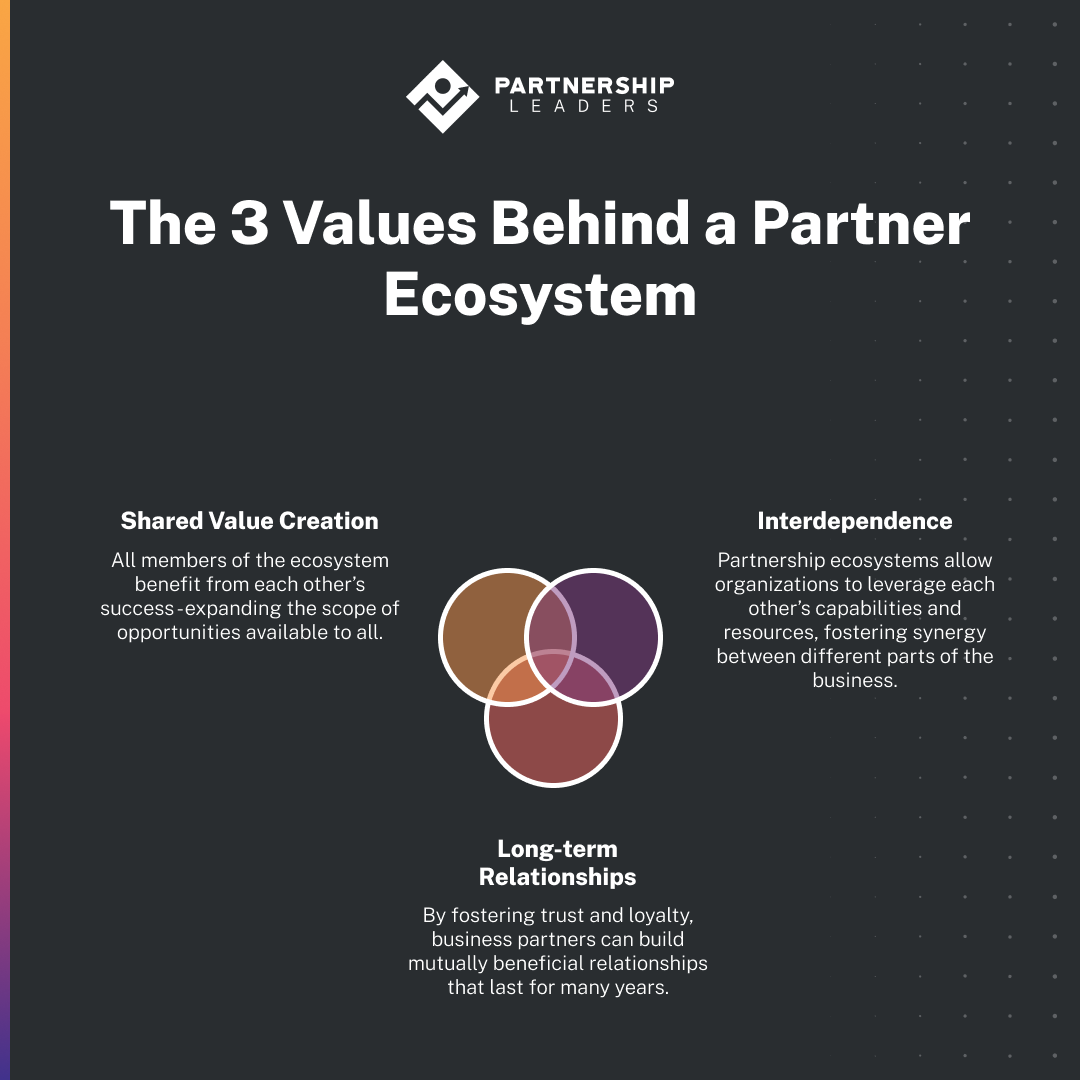Partnerships have become pivotal to fostering innovation, expanding market reach, and delivering unparalleled customer value. Therefore, understanding the concept of the partnership ecosystem is crucial for organizations aiming to leverage channel partner programs effectively.
This blog explores partnership ecosystems, explaining why they are indispensable for channel partner programs.
What is a Partnership Ecosystem?
A partnership ecosystem is a network of organizations working together to achieve mutual goals, such as:
- Suppliers
- Distributors
- Customers
- Competitors
- Government agencies
- Other related entities
Unlike traditional partnership models that are often linear and transactional, an ecosystem approach is multifaceted, emphasizing the following values:
- Interdependence: Partnership ecosystems allow organizations to leverage each other’s capabilities and resources, fostering synergy between different parts of the business.
- Shared value creation: All members of the ecosystem benefit from each other’s success – expanding the scope of opportunities available to all.
- Long-term relationships: By fostering trust and loyalty, business partners can build mutually beneficial relationships that last for many years.
A partnership ecosystem is more than just a sum of its parts. It’s a dynamic system where each entity brings unique strengths, capabilities, and resources to the table. When orchestrated effectively, these companies can co-create solutions, drive innovation, and tap into new market opportunities that would be challenging to achieve in isolation.
Companies are no longer confined to their industry silos. Instead, they actively seek cross-industry collaborations, blurring the lines between sectors and redefining how businesses operate and deliver value to their customers.

The Importance of a Partnership Ecosystem in Channel Partner Programs
Channel partner programs have long been a staple in the business world, enabling companies to expand their reach, enhance their offerings, and drive growth. However, our increasing connectivity requires overhauling how we view channel partnerships.
This is where the partnership ecosystem comes into play, offering a more holistic and integrated approach to collaboration.
1. Meeting Changing Customer Expectations
Customers today demand more than just products or services. They seek comprehensive solutions that address their unique challenges and needs. A partnership ecosystem allows companies to pool their expertise, resources, and technologies to deliver such tailored solutions.
By collaborating with a diverse set of partners, companies can offer a richer customer experience, meeting and often exceeding the ever-evolving expectations of their clientele.
2. Broadening Innovation and Delivering Solutions
Innovation is no longer confined to the walls of a single organization. Companies tap into a vast reservoir of ideas, technologies, and capabilities in a partnership ecosystem.
This approach to innovation accelerates the development of groundbreaking solutions. Whether it’s integrating advanced technologies, co-developing products, or exploring new market segments, the collective intelligence of the ecosystem drives innovation at an unprecedented scale.
3. The Shift from Transactional Relationships to Ecosystem Collaborations
Traditional channel partnerships often revolved around transactional interactions, primarily sales and distribution. However, the emphasis shifts to building more profound, strategic relationships in a partnership ecosystem.
These collaborations are rooted in mutual trust, shared objectives, and a commitment to long-term growth. Instead of merely acting as vendors or distributors, partners become co-creators, stakeholders, and advocates, playing a pivotal role in the company’s success journey.
Key Components of a Successful Partnership Ecosystem
Certain foundational elements must be in place for a partnership ecosystem to thrive. These components ensure that collaborations are effective and sustainable in the long run.
1. Co-innovation
Co-innovation is the lifeblood of a vibrant partnership ecosystem. It involves partners coming together to brainstorm, design, and develop novel solutions that cater to market demands.
This approach to innovation allows for a fusion of diverse perspectives, leading to more comprehensive and market-relevant solutions. Moreover, co-innovation fosters a sense of joint ownership, ensuring that all partners are invested in the success of the developed solutions.
2. Collaboration
While one-on-one partnerships have their merits, a partnership ecosystem thrives on collaboration at scale. This means creating platforms, processes, and frameworks that enable multiple partners to collaborate seamlessly.
Such large-scale collaborations can lead to the pooling of resources, knowledge-sharing, and the creation of solutions that cater to a broader market segment. Effective communication, transparent governance, and shared objectives are crucial for successful collaboration at scale.
3. Co-investment
A true partnership goes beyond immediate gains. It’s about envisioning a shared future and investing in it. Co-investment in a partnership ecosystem context means that partners jointly invest in initiatives, technologies, or markets that promise future returns.
This could involve:
- Setting up joint research labs: Constructing a research environment that allows partners to explore and develop breakthrough technologies.
- Funding startups: Investing in ideas or projects by providing resources such as capital, expertise, and market connections.
- Exploring new geographies: Exploring new territories, markets, and cultures to understand prospective customers or partners better.
Co-investing signals a deep commitment to the partnership and a shared belief in the envisioned future.
Conclusion
Partnership ecosystems enable companies to respond more agilely to changing customer expectations, drive innovation at scale, and transition from mere transactional relationships to deep-rooted strategic collaborations.
As customer demands become more complex and the lines between industries blur, channel partners that are part of a robust ecosystem will be better positioned to offer comprehensive solutions, tap into new opportunities, and drive sustained growth.
Join The 1850+ Leaders Transforming Partnerships
As a member of Partnership Leaders, you will:
- Build and learn with the top partner people at the best companies around the world.
- Increase your impact and accelerate your career with proven resources, tools, and best practices.
- Grow a network of peers, partners, and advisors with common objectives.
Maximize your business impact with ecosystem partnerships, where companies move beyond simple reseller relationships and unite in dynamic, interconnected networks to deliver comprehensive, high-value solutions. A partnership ecosystem empowers organizations to respond faster to evolving customer demands, spur co-innovation, and shift from transactional ties to deep, strategic collaborations pooling expertise, investments, and technologies for mutual gain. If you’re ready to level up and tap into top-tier guidance, visit partnership leaders to access tools, frameworks, and a global community designed to help you build, manage, and profit from powerful ecosystem alliances.


